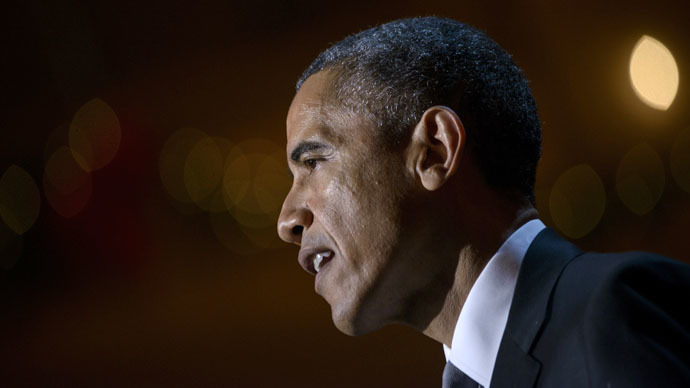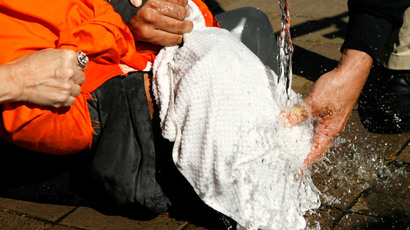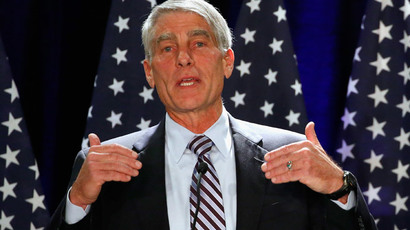Feds’ fight to withhold CIA torture photos may soon end

While much of the world is still reeling from the disclosures contained in the Senate Intelligence Committee’s torture report released last week, more damning evidence about the treatment of detainees could soon make its away to the surface.
According to recent reports, a federal judge in New York City is expected to hear from the United States government’s attorneys this week about why a cache of classified photographs shouldn’t see the light of the day.
The images at the center of the argument predate the current White House administration, as does the fight to have them made public. The cache of pictures – taken at CIA-run detention centers opened overseas in the wake of the September 11 terrorist attacks to hold and interrogate suspects – are believed to be among the worst records in existence concerning post-9/11 operations waged by the CIA when detainees were tortured by American officials through a program that the Senate Intelligence Committee recently concluded to have been largely ineffective.
For a decade now, a legal back-and-forth has continued to brew between lawyers for the American Civil Liberties Union intent on having the photos released, and government attorneys operating under first President George W. Bush, then President Barack Obama, to keep the images from public eyes. The Second Circuit Court of Appeals said in 2008 that a 21-photo subset of the images should be released, but President Obama argued that doing as much would “further inflame anti-American opinion and...put our troops in greater danger.” Soon after, the Protected National Security Documents Act (PNSDA) was passed, allowing the Pentagon to withhold certain images should a court agree with whatever rationale is argued.
Yet “the government failed to show that it had adequate basis for the certification,” Judge Alvin Hellerstein ruled for the Southern District of New York in August, after the administration said the images should be sealed as a matter of national security. In October, the Guardian reported that Judge Hellerstein told US Justice Department attorneys that they had until December 12, last Friday, to “list, photograph by photograph, the government’s rationale for keeping redacted versions of the photos unseen by the public.” According to an article published by the Daily Beast over the weekend, Hellerstein has given the government until December 19, this Friday, “to submit evidence that the secretary of defense has individually certified each photograph to be a danger to national security.”
Pending Judge Hellerstein’s impending decision, the potential release of the photos could once again rekindle a storm of anti-American sentiment, as well as expose even further the true nature and scope of the CIA’s torture program so soon after a Senate panel exposed some of that operation’s darkest secrets.
According to the Daily Beast, photographs being considered show US soldiers posing with the bodies of dead detainees and live prisoners, in a series of upsetting positions. Many of the images, the website reported, come from the infamous Abu Gharib detention facility, which previously prompted international outrage upon the leaking of pictures photographed within its walls.
“These photos we’re told show mistreatment from facilities throughout Afghanistan and Iraq, not just Abu Ghraib, and I think they would once and for all prove that mistreatment at the hands of the military was widespread, not isolated,” Alex Abdo, an ACLU attorney working on the lawsuit, told The National last week. “If we want to ensure that these abuses never reoccur then having some form of accountability is necessary.”
In Sunday’s Daily Beast article, Jameel Jaffer, the ACLU attorney who has fought for the photos’ release since 2004, is quoted as saying that he thinks the government lacks good standing to keep the images under seal.
“To accept the government's argument, that information about government misconduct should be suppressed whenever there is some risk that someone, somewhere in the world will be upset by it, is a formula for the suppression of all sorts of information that are critical to our democracy,” Jaffer said.
“The public has a right to know what happened in these military detention facilities,” he continued, “in the same way it has a right to know about what happened at the CIA black sites.”
Last week, the Senate Intelligence Committee published the executive summary pertaining to the 6,000-page, years-in-the-making congressional probe concerning the CIA’s use of torture tactics against foreign detainees. According to the panel’s chairperson, Sen. Dianne Feinstein (D-California), the committee’s probe concluded that the CIA routinely lied about the effects of so-called enhanced interrogation techniques, or EITs, such as waterboarding and sleep-deprivation, and that they cannot be attributed with directly eliciting any critical information from suspected terrorists to American officials.














